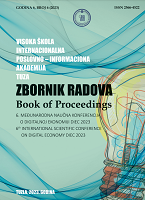COMPARATIVE ANALYSIS OF DIFFERENT SEGMENTS OF AIR QUALITY SENSORS FOR THE FIELD OF SMART ENVIRONMENT AND THEIR IMPORTANCE FOR THE DEVELOPMENT OF SMART CITIES
COMPARATIVE ANALYSIS OF DIFFERENT SEGMENTS OF AIR QUALITY SENSORS FOR THE FIELD OF SMART ENVIRONMENT AND THEIR IMPORTANCE FOR THE DEVELOPMENT OF SMART CITIES
Author(s): Valerij GrašičSubject(s): Energy and Environmental Studies, Social development, Health and medicine and law, Economic development, Environmental interactions
Published by: Internacionalna poslovno – informaciona akademija
Keywords: Smart City; Smart Environment; Air Quality; IoT; Open Data;
Summary/Abstract: The development of smart cities is considered to consist of several sub-fields and to be conditioned by an ever-increasing number of sensors and IoT devices. These sensors’ data are freely available to a large extent, which is why we call them open data. The field of our research is the smart environment as part of a smart city, more specifically the field of air quality. The mentioned area is very important because through it we can evaluate the quality of the air, both for example, if the quality is bad or if the quality is good. If the quality is bad, it has a negative effect on people’s health. But if the quality is very good, this is an additional argument for raising the quality of people’s lives. For the example of one of the Slovenian cities, we are interested in a comparative analysis of the use of a combination of many different sensor segments. Because in the case of air quality, the sensors can not only be different, but they can also be of completely different quality and offer different capabilities. We are interested in the difference between the sensors, what this means for the air quality measurement itself, what is with the openness of the data, and how is the connection of the data from these different sensors. We are also interested in how we can better assess the air quality for a certain micro-location based on all this data. The given research with the analysis and comparison of different segments of air quality sensors will help us in preparing a comprehensive approach to the control and management of air quality and, consequently, to the development of smart cities.
Journal: Zbornik radova Međunarodne naučne konferencije o digitalnoj ekonomiji DIEC
- Issue Year: 6/2023
- Issue No: 6
- Page Range: 189-204
- Page Count: 16
- Language: English

